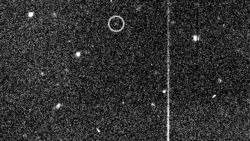Astronomy:Mundilfari (moon)
 Discovery images of Mundilfari (circled) taken by the CFHT in September 2000 | |
| Discovery | |
|---|---|
| Discovered by | Gladman et al. |
| Discovery date | 2000 |
| Designations | |
Designation | Saturn XXV |
| Pronunciation | Icelandic: [ˈmʏntɪlvarɪ][1] |
| Named after | Mundilfari |
| S/2000 S 9 | |
| Orbital characteristics [3] | |
| 18685000 km (18360000 km[2]) | |
| Eccentricity | 0.210 (0.198[2]) |
| Orbital period | −952.6 days (−928.8 days[2]) |
| Inclination | 167.3° (150°[2]) |
| Satellite of | Saturn |
| Group | Norse group |
| Physical characteristics | |
| Mean diameter | 7+50% −30% km[2] |
| Rotation period | 6.74±0.08 hours[2] |
Spectral type | P |
| Apparent magnitude | 23.8[3] |
Mundilfari, or Saturn XXV, is a natural satellite of Saturn. It was discovered by Brett J. Gladman, et al. in 2000, and given the temporary designation S/2000 S 9. Mundilfari is about 7 kilometres in diameter, and orbits Saturn at an average distance of 18,360 Mm in 928.806 days, at an inclination of 170° to the ecliptic (150° to Saturn's equator), in a retrograde direction and with an eccentricity of 0.198.[2]
Mundilfari may have formed from debris knocked off Phoebe by large impacts at some point in the Solar System's history. With a spectral slope of −5.0%/100 , Mundilfari is the bluest of all the moons studied by Grav and Bauer (2007), slightly more so than Phoebe (−2.5%/100 nm) and about as blue as Erriapus (+5.1%/100 nm) is red. Its rotation period is 6.74±0.08 hours, the second-fastest among all the irregular moons studied by Cassini–Huygens,[2] and it appears to be very elongated in shape.[4]
It was named in August 2003 from Norse mythology, where Mundilfari is the father of the goddess Sól (Sun) and the god Mani (Moon).
References
- ↑ The name is also found as Mundilföri ~ Mundilfœri. This would correspond to modern Icelandic Mundilfæri [ˈmʏntɪlvairɪ].
- ↑ 2.0 2.1 2.2 2.3 2.4 2.5 2.6 2.7 Denk, T.; Mottola, S. (2019). "Cassini Observations of Saturn's Irregular Moons". 50th Lunar and Planetary Science Conference. Lunar and Planetary Institute. https://www.hou.usra.edu/meetings/lpsc2019/pdf/2654.pdf.
- ↑ 3.0 3.1 S.S. Sheppard (2019), Moons of Saturn, Carnegie Science, on line
- ↑ Denk, T.; Mottola, S.; Bottke, W. F.; Hamilton, D. P. (2018). "The Irregular Satellites of Saturn". Enceladus and the Icy Moons of Saturn. 322. University of Arizona Press. pp. 409–434. doi:10.2458/azu_uapress_9780816537075-ch020. ISBN 9780816537488. Bibcode: 2018eims.book..409D. https://tilmanndenk.de/wp-content/uploads/DenkEtAl2018_IrregularMoons.pdf.
- IAUC 7538: S/2000 S 7, S/2000 S 8, S/2000 S 9 December 7, 2000 (discovery)
- MPEC 2000-Y15: S/2000 S 1, S/2000 S 2, S/2000 S 7, S/2000 S 8, S/2000 S 9 December 19, 2000 (discovery and ephemeris)
- IAUC 8177: Satellites of Jupiter, Saturn, Uranus August 8, 2003 (naming the moon)
 |



